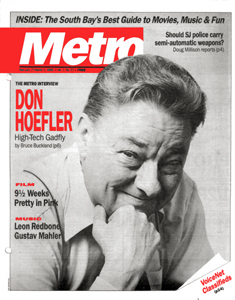![[Metroactive Features]](http://metroactive.com/features/gifs/feat468.gif)
[ Features Index | Silicon Valley | Metroactive Home | Archives ]
Metro's 20th Anniversary
For 20 Years, You've Been News to Us
You could say that Metro's news coverage goes back as far as Silicon Valley itself—at least the name. In among our earliest issues was a cover story on Don Hoefler, which contained the last known interview with the man who coined the very term "Silicon Valley." Let's just say that Don didn't mean it as a compliment.
Damn, we miss that guy. The last maverick standing in an era of shiny hair helmets, he knew how to tell it like it was. We won't say he was our hero, 'cause like the Stranger said, what's a hero? But we did start our own tradition of talking about uncomfortable truths in San Jose, taking on stories like:
In the two decades since, Metro staffers have won numerous awards for investigative reporting, as well as for general news stories, business reporting, environmental reporting, stories championing freedom of information, news photos, editorial cartoons and more.
But it hasn't been all big stories, splashy covers and awards banquets. Metro's news coverage has never been afraid to get up to its elbows in gunk, which explains how we managed to keep tabs on the San Jose political landscape in our pioneering Public Eye column. We're talking the column that broke the story statewide of Jerry Brown's political comeback in 1988, when we learned he was planning to run for chair of the state Democratic Party. (Hey, give us a break—we didn't cause Jerry Brown's political comeback.) After getting burned by Public Eye time and again, the Mercury News finally launched a PE clone in 1988—"The Insider," which was later resuscitated as "Internal Affairs." But we kept looking ahead—our coverage continued to evolve, but political gossip has always had a special place in our pages (and our hearts). You can still get the scoop every week in The Fly.
Looking back on 20 years of news, we realize the valley we grew up reporting on has grown up right along with us. So we thought we'd take a look at exactly how some of our favorite news haunts—from downtown to the tech industry and the rest of the business sector to the ag lands that spawned San Jose's economy in the first place—have changed in the last 20 years. And in honor of Mr. Silicon Valley, Don Hoefler, we've also taken a look at what area visionaries have been up to in the last 20 years. And we just want to say thanks, Silicon Valley, for being news to us.
Timeline
[ Silicon Valley | Metroactive Home | Archives ]
Copyright © Metro Publishing Inc. Metroactive is affiliated with the Boulevards Network.
For more information about the San Jose/Silicon Valley area, visit sanjose.com.
![]()
![[line]](/gifs/line.gif)
20 Years of News: Thanks, Silicon Valley, for being news to us.
Sub-Urban: For 20 years, San Jose's downtown has grown in everything but stature. What's it going to take to get a little respect?
Lost Roots: In the last 20 years, Silicon Valley has finally realized that it needs to preserve its agricultural heritage—in museums. Meanwhile, land that could be saved is being marked for development.
Tech Will Eat Itself: Boom! Bust! Boom? Drink this Kool-Aid to remember the wacky and possibly circular history of Silicon Valley high tech in the last 20 years.
Blinded by Science: Silicon Valley has a reputation as the home of the cutting-edge scientific innovatiors. But what have they done for us lately?
![[line]](/gifs/line.gif)

Mr. Silicon Valley: This issue from 1986 contained the last interview with Don Hoefler, who was best known for coining the phrase 'Silicon Valley,' but was equally important as a critical voice in a time of explosive growth.
Send a letter to the editor about this story to letters@metronews.com.
From the March 9-15, 2005 issue of Metro, Silicon Valley's Weekly Newspaper.